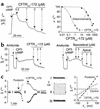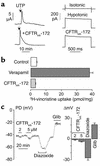Thiazolidinone CFTR inhibitor identified by high-throughput screening blocks cholera toxin-induced intestinal fluid secretion
- PMID: 12464670
- PMCID: PMC151633
- DOI: 10.1172/JCI16112
Thiazolidinone CFTR inhibitor identified by high-throughput screening blocks cholera toxin-induced intestinal fluid secretion
Abstract
Secretory diarrhea is the leading cause of infant death in developing countries and a major cause of morbidity in adults. The cystic fibrosis transmembrane conductance regulator (CFTR) protein is required for fluid secretion in the intestine and airways and, when defective, causes the lethal genetic disease cystic fibrosis. We screened 50,000 chemically diverse compounds for inhibition of cAMP/flavone-stimulated Cl(-) transport in epithelial cells expressing CFTR. Six CFTR inhibitors of the 2-thioxo-4-thiazolidinone chemical class were identified. The most potent compound discovered by screening of structural analogs, CFTR(inh)-172, reversibly inhibited CFTR short-circuit current in less than 2 minutes in a voltage-independent manner with K(I) approximately 300 nM. CFTR(inh)-172 was nontoxic at high concentrations in cell culture and mouse models. At concentrations fully inhibiting CFTR, CFTR(inh)-172 did not prevent elevation of cellular cAMP or inhibit non-CFTR Cl(-) channels, multidrug resistance protein-1 (MDR-1), ATP-sensitive K(+) channels, or a series of other transporters. A single intraperitoneal injection of CFTR(inh)-172 (250 micro g/kg) in mice reduced by more than 90% cholera toxin-induced fluid secretion in the small intestine over 6 hours. Thiazolidinone CFTR inhibitors may be useful in developing large-animal models of cystic fibrosis and in reducing intestinal fluid loss in cholera and other secretory diarrheas.
Figures





Comment in
-
Alternative treatment for secretory diarrhea revealed in a new class of CFTR inhibitors.J Clin Invest. 2002 Dec;110(11):1599-601. doi: 10.1172/JCI17301. J Clin Invest. 2002. PMID: 12464662 Free PMC article. No abstract available.
Similar articles
-
Identification of new small molecule inhibitors of cystic fibrosis transmembrane conductance regulator protein: in vitro and in vivo studies.Biol Pharm Bull. 2007 Mar;30(3):502-7. doi: 10.1248/bpb.30.502. Biol Pharm Bull. 2007. PMID: 17329846
-
Prevention of toxin-induced intestinal ion and fluid secretion by a small-molecule CFTR inhibitor.Gastroenterology. 2004 Feb;126(2):511-9. doi: 10.1053/j.gastro.2003.11.005. Gastroenterology. 2004. PMID: 14762788
-
Lectin conjugates as potent, nonabsorbable CFTR inhibitors for reducing intestinal fluid secretion in cholera.Gastroenterology. 2007 Apr;132(4):1234-44. doi: 10.1053/j.gastro.2007.02.018. Epub 2007 Feb 7. Gastroenterology. 2007. PMID: 17408659
-
CFTR chloride channel drug discovery--inhibitors as antidiarrheals and activators for therapy of cystic fibrosis.Curr Pharm Des. 2006;12(18):2235-47. doi: 10.2174/138161206777585148. Curr Pharm Des. 2006. PMID: 16787252 Review.
-
CFTR pharmacology and its role in intestinal fluid secretion.Curr Opin Pharmacol. 2003 Dec;3(6):594-9. doi: 10.1016/j.coph.2003.06.012. Curr Opin Pharmacol. 2003. PMID: 14644010 Review.
Cited by
-
Thermal instability of ΔF508 cystic fibrosis transmembrane conductance regulator (CFTR) channel function: protection by single suppressor mutations and inhibiting channel activity.Biochemistry. 2012 Jun 26;51(25):5113-24. doi: 10.1021/bi300018e. Epub 2012 Jun 15. Biochemistry. 2012. PMID: 22680785 Free PMC article.
-
Benzopyrimido-pyrrolo-oxazine-dione (R)-BPO-27 Inhibits CFTR Chloride Channel Gating by Competition with ATP.Mol Pharmacol. 2015 Oct;88(4):689-96. doi: 10.1124/mol.115.098368. Epub 2015 Jul 14. Mol Pharmacol. 2015. PMID: 26174774 Free PMC article.
-
Coordinated epithelial NHE3 inhibition and barrier dysfunction are required for TNF-mediated diarrhea in vivo.J Clin Invest. 2006 Oct;116(10):2682-94. doi: 10.1172/JCI29218. J Clin Invest. 2006. PMID: 17016558 Free PMC article.
-
Lysophosphatidic acid inhibits cholera toxin-induced secretory diarrhea through CFTR-dependent protein interactions.J Exp Med. 2005 Oct 3;202(7):975-86. doi: 10.1084/jem.20050421. J Exp Med. 2005. PMID: 16203867 Free PMC article.
-
Epac1 mediates protein kinase A-independent mechanism of forskolin-activated intestinal chloride secretion.J Gen Physiol. 2010 Jan;135(1):43-58. doi: 10.1085/jgp.200910339. J Gen Physiol. 2010. PMID: 20038525 Free PMC article.
References
-
- Grubb BR, Boucher RC. Pathophysiology of gene-targeted mouse models for cystic fibrosis. Physiol Rev. 1999;79(Suppl.):S193–S214. - PubMed
-
- Wong PY. CFTR gene and male fertility. Mol Hum Reprod. 1997;4:107–110. - PubMed
-
- Pilewski JM, Frizzell RA. Role of CFTR in airway disease. Physiol Rev. 1999;79(Suppl.):S215–S255. - PubMed
-
- Cabantchik ZI, Greger R. Chemical probes for anion transporters of mammalian cell membranes. Am J Physiol. 1992;262:C803–C827. - PubMed
-
- McDonough S, Davidson N, Lester HA, McCarty NA. Novel pore-lining residues in CFTR that govern permeation and open-channel block. Neuron. 1994;13:623–634. - PubMed
Publication types
MeSH terms
Substances
Grants and funding
LinkOut - more resources
Full Text Sources
Other Literature Sources
Medical
Research Materials

